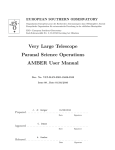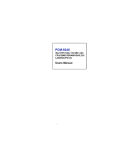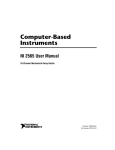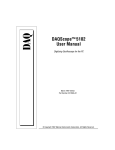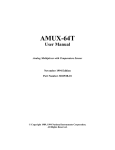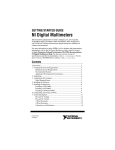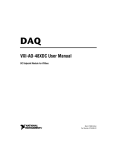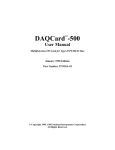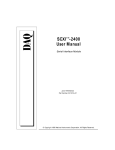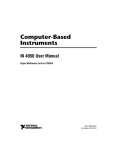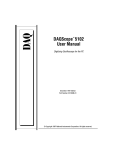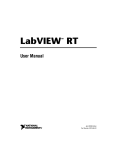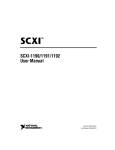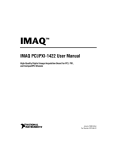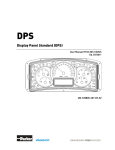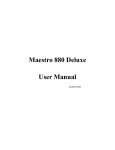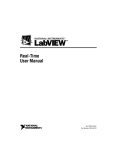Download DAQMeter/DAQCard-4050 User Manual
Transcript
DAQMeter DAQCard-4050 User Manual Digital Multimeter Card for PCMCIA DAQMeter DAQCard-4050 User Manual February 1997 Edition Part Number 321427A-01 © Copyright 1997 National Instruments Corporation. All Rights Reserved. Internet Support [email protected] E-mail: [email protected] FTP Site: ftp.natinst.com Web Address: http://www.natinst.com Bulletin Board Support BBS United States: (512) 794-5422 BBS United Kingdom: 01635 551422 BBS France: 01 48 65 15 59 Fax-on-Demand Support (512) 418-1111 Telephone Support (U.S.) Tel: (512) 795-8248 Fax: (512) 794-5678 International Offices Australia 03 9879 5166, Austria 0662 45 79 90 0, Belgium 02 757 00 20, Canada (Ontario) 905 785 0085, Canada (Québec) 514 694 8521, Denmark 45 76 26 00, Finland 09 527 2321, France 01 48 14 24 24, Germany 089 741 31 30, Hong Kong 2645 3186, Israel 03 5734815, Italy 02 413091, Japan 03 5472 2970, Korea 02 596 7456, Mexico 5 520 2635, Netherlands 0348 433466, Norway 32 84 84 00, Singapore 2265886, Spain 91 640 0085, Sweden 08 730 49 70, Switzerland 056 200 51 51, Taiwan 02 377 1200, U.K. 01635 523545 National Instruments Corporate Headquarters 6504 Bridge Point Parkway Austin, TX 78730-5039 Tel: (512) 794-0100 Important Information Warranty The DAQMeter DAQCard-4050 is warranted against defects in materials and workmanship for a period of one year from the date of shipment, as evidenced by receipts or other documentation. National Instruments will, at its option, repair or replace equipment that proves to be defective during the warranty period. This warranty includes parts and labor. The media on which you receive National Instruments software are warranted not to fail to execute programming instructions, due to defects in materials and workmanship, for a period of 90 days from date of shipment, as evidenced by receipts or other documentation. National Instruments will, at its option, repair or replace software media that do not execute programming instructions if National Instruments receives notice of such defects during the warranty period. National Instruments does not warrant that the operation of the software shall be uninterrupted or error free. A Return Material Authorization (RMA) number must be obtained from the factory and clearly marked on the outside of the package before any equipment will be accepted for warranty work. National Instruments will pay the shipping costs of returning to the owner parts which are covered by warranty. National Instruments believes that the information in this manual is accurate. The document has been carefully reviewed for technical accuracy. In the event that technical or typographical errors exist, National Instruments reserves the right to make changes to subsequent editions of this document without prior notice to holders of this edition. The reader should consult National Instruments if errors are suspected. In no event shall National Instruments be liable for any damages arising out of or related to this document or the information contained in it. EXCEPT AS SPECIFIED HEREIN , NATIONAL INSTRUMENTS MAKES NO WARRANTIES, EXPRESS OR IMPLIED, AND SPECIFICALLY DISCLAIMS ANY WARRANTY OF MERCHANTABILITY OR FITNESS FOR A PARTICULAR PURPOSE . CUSTOMER’S RIGHT TO RECOVER DAMAGES CAUSED BY FAULT OR NEGLIGENCE ON THE PART OF N ATIONAL INSTRUMENTS SHALL BE LIMITED TO THE AMOUNT THERETOFORE PAID BY THE CUSTOMER . NATIONAL INSTRUMENTS WILL NOT BE LIABLE FOR DAMAGES RESULTING FROM LOSS OF DATA , PROFITS , USE OF PRODUCTS, OR INCIDENTAL OR CONSEQUENTIAL DAMAGES , EVEN IF ADVISED OF THE POSSIBILITY THEREOF. This limitation of the liability of National Instruments will apply regardless of the form of action, whether in contract or tort, including negligence. Any action against National Instruments must be brought within one year after the cause of action accrues. National Instruments shall not be liable for any delay in performance due to causes beyond its reasonable control. The warranty provided herein does not cover damages, defects, malfunctions, or service failures caused by owner’s failure to follow the National Instruments installation, operation, or maintenance instructions; owner’s modification of the product; owner’s abuse, misuse, or negligent acts; and power failure or surges, fire, flood, accident, actions of third parties, or other events outside reasonable control. Copyright Under the copyright laws, this publication may not be reproduced or transmitted in any form, electronic or mechanical, including photocopying, recording, storing in an information retrieval system, or translating, in whole or in part, without the prior written consent of National Instruments Corporation. Trademarks LabVIEW® , NI-DAQ®, ComponentWorks™, CVI™, DAQCard™, DAQMeter™, SCXI™, and VirtualBench™ are trademarks of National Instruments Corporation. Product and company names listed are trademarks or trade names of their respective companies. WARNING REGARDING MEDICAL AND CLINICAL USE OF NATIONAL INSTRUMENTS PRODUCTS National Instruments products are not designed with components and testing intended to ensure a level of reliability suitable for use in treatment and diagnosis of humans. Applications of National Instruments products involving medical or clinical treatment can create a potential for accidental injury caused by product failure, or by errors on the part of the user or application designer. Any use or application of National Instruments products for or involving medical or clinical treatment must be performed by properly trained and qualified medical personnel, and all traditional medical safeguards, equipment, and procedures that are appropriate in the particular situation to prevent serious injury or death should always continue to be used when National Instruments products are being used. National Instruments products are NOT intended to be a substitute for any form of established process, procedure, or equipment used to monitor or safeguard human health and safety in medical or clinical treatment. Table of Contents About This Manual Organization of This Manual ........................................................................................ ix Conventions Used in This Manual................................................................................ x National Instruments Documentation ........................................................................... x Related Documentation................................................................................................. xi Customer Communication ............................................................................................ xi Chapter 1 Introduction About the DAQMeter DAQCard-4050......................................................................... 1-1 What You Need to Get Started ..................................................................................... 1-2 Software Programming Choices ................................................................................... 1-2 National Instruments Application Software ................................................... 1-2 VirtualBench................................................................................................... 1-3 DAQMeter DAQCard-4050 Instrument Driver and NI-DAQ ....................... 1-3 Optional Equipment ...................................................................................................... 1-5 Unpacking ..................................................................................................................... 1-5 Chapter 2 Installation and Configuration Safety Instructions ........................................................................................................ 2-1 Installation .................................................................................................................... 2-2 Cable and Probes .......................................................................................................... 2-3 Hardware Configuration ............................................................................................... 2-4 Chapter 3 DMM Operation Warm-up ....................................................................................................................... 3-1 Choosing a Reading Rate.............................................................................................. 3-1 Measuring Voltages ...................................................................................................... 3-2 DC Voltages ................................................................................................... 3-3 Input Ranges .................................................................................... 3-3 © National Instruments Corporation v DAQMeter DAQCard-4050 User Manual Table of Contents Accuracy Considerations ................................................................. 3-3 Input Impedance................................................................ 3-3 AC Noise Effects............................................................... 3-4 Thermal EMF .................................................................... 3-4 AC Voltages ................................................................................................... 3-5 True RMS Method........................................................................... 3-5 Input Ranges .................................................................................... 3-5 Accuracy Considerations ................................................................. 3-6 Frequency Response.......................................................... 3-6 Crest Factor ....................................................................... 3-7 AC Voltage Offset............................................................. 3-8 Measuring Resistance................................................................................................... 3-8 Signal Connections ........................................................................................ 3-8 Input Ranges .................................................................................................. 3-9 Continuity Measurements .............................................................................. 3-10 Testing Diodes.............................................................................................................. 3-10 Signal Connections ........................................................................................ 3-10 Measuring Current........................................................................................................ 3-11 Appendix A Specifications Appendix B PC Card Questions and Answers Appendix C Customer Communication Glossary Index DAQMeter DAQCard-4050 User Manual vi © National Instruments Corporation Table of Contents Figures Figure 1-1. The Relationship between the Programming Environment, NI-DAQ, and Your Hardware ............................................................... 1-4 Figure 2-1. Figure 2-2. Installing the DAQCard-4050 and Cables ............................................. 2-3 Probe Types ........................................................................................... 2-4 Figure 3-1. Figure 3-2. Figure 3-3. Figure 3-4. Figure 3-5. Connecting Probes for Voltage Measurement ....................................... 3-2 The Effect of Input Impedance on Signal Measurement ....................... 3-4 Connections for Resistance Measurement............................................. 3-8 Connections for Diode Measurement .................................................... 3-10 Connections for Current Measurement.................................................. 3-11 Tables Table 3-1. Table 3-2. Table 3-3. Table 3-4. Table 3-5. DC Input Range Accuracy ..................................................................... 3-3 AC Input Range Accuracy ..................................................................... 3-6 Input Frequency Error Rate ................................................................... 3-7 Crest Factor Error Rate .......................................................................... 3-7 Resistance Input Range Accuracy ......................................................... 3-9 © National Instruments Corporation vii DAQMeter DAQCard-4050 User Manual About This Manual This manual describes the electrical and mechanical aspects of the DAQMeter DAQCard-4050 and contains information concerning its operation and programming. The DAQMeter DAQCard-4050 is a digital multimeter card for computers with Type II PCMCIA slots compliant with revision 2.1 of the PCMCIA specifications. Organization of This Manual The DAQMeter DAQCard-4050 User Manual is organized as follows: • Chapter 1, Introduction, describes the DAQMeter DAQCard-4050, lists what you need to get started, describes the optional software and optional equipment, and explains how to unpack your card. • Chapter 2, Installation and Configuration, explains safety instructions and describes how to install and configure a DAQMeter DAQCard-4050. • Chapter 3, DMM Operation, describes how to use your DAQMeter DAQCard-4050 and includes operation tips on taking voltage, resistance, diode, and current readings. • Appendix A, Specifications, lists the specifications for the DAQMeter DAQCard-4050. • Appendix B, PC Card Questions and Answers, contains a list of common questions and answers relating to PC Card (PCMCIA) operation. • Appendix C, Customer Communication, contains forms you can use to request help from National Instruments or to comment on our products. • The Glossary contains an alphabetical list and description of terms used in this manual, including acronyms, abbreviations, metric prefixes, mnemonics, and symbols. • The Index alphabetically lists topics covered in this manual, including the page where you can find the topic. © National Instruments Corporation ix DAQMeter DAQCard-4050 User Manual About This Manual Conventions Used in This Manual The following conventions are used in this manual: bold Bold text denotes the names of menus, menu items, parameters, dialog boxes, dialog box buttons or options, icons, windows, Windows 95 tabs, or LEDs. bold italic Bold italic text denotes a note, caution, or warning. italic Italic text denotes emphasis, a cross reference, or an introduction to a key concept. This font also denotes text from which you supply the appropriate word or value, as in Windows 3.x. monospace Text in this font denotes text or characters that should literally enter from the keyboard, sections of code, programming examples, and syntax examples. This font is also used for the proper names of disk drives, paths, directories, programs, subprograms, subroutines, device names, functions, operations, variables, filenames and extensions, and for statements and comments taken from programs. The Glossary lists abbreviations, acronyms, metric prefixes, mnemonics, symbols, and terms. National Instruments Documentation The DAQMeter DAQCard-4050 User Manual is one piece of the documentation set for your DAQ system. You could have any of several types of manuals depending on the hardware and software in your system. Use the manuals you have as follows: • Your DAQ hardware user manuals—These manuals have detailed information about the DAQ hardware that plugs into or is connected to your computer. Use these manuals for hardware installation and configuration instructions, specification information about your DAQ hardware, and application hints. • Software documentation—You might have several sets of software documentation, including LabVIEW, LabWindows ®/CVI, VirtualBench, and NI-DAQ. After you have set up your hardware system, use either the application software (LabVIEW or LabWindows/CVI) or the NI-DAQ documentation to help you write your application. If you have a large and complicated system, it is worthwhile to look through the software documentation before you configure your hardware. DAQMeter DAQCard-4050 User Manual x © National Instruments Corporation About This Manual • Accessory installation guides or manuals—If you are using accessory products, read the terminal block and cable assembly installation guides. They explain how to physically connect the relevant pieces of the system. Consult these guides when you are making your connections. Related Documentation The following document contains information that you may find helpful: • Your computer user manual Customer Communication National Instruments wants to receive your comments on our products and manuals. We are interested in the applications you develop with our products, and we want to help if you have problems with them. To make it easy for you to contact us, this manual contains comment and configuration forms for you to complete. These forms are in Appendix C, Customer Communication, at the end of this manual. © National Instruments Corporation xi DAQMeter DAQCard-4050 User Manual Chapter 1 Introduction This chapter describes the DAQMeter DAQCard-4050, lists what you need to get started, describes the optional software and optional equipment, and explains how to unpack your card. About the DAQMeter DAQCard-4050 Thank you for buying a National Instruments DAQMeter DAQCard-4050. The DAQCard-4050 is a digital multimeter card for computers equipped with Type II PCMCIA slots. The DAQCard-4050 features accurate 5 1/2-digit DC voltage, true root mean square (RMS) AC voltage, ohm, and diode measurements in a PC Card format. You can use the card to make the same measurements you would with a standard benchtop digital multimeter. The DAQCard-4050 contains a 24-bit analog-to-digital converter (ADC) with digital filtering, which gives the card excellent resolution, accuracy, and noise rejection. Coupled with a CSM series current shunt module available from National Instruments, the DAQCard-4050 also effectively measures AC and DC current. The DAQCard-4050’s small size, weight, and low power consumption make this device ideal for use in portable computers, which makes remote measurements and data-logging practical. The DAQCard-4050 requires very little power when in operation, thus extending the life of your computer batteries. A system based on the DAQCard-4050 offers the flexibility, performance, and size that makes it ideal for service, repair, and manufacturing as well as for use in industrial and laboratory environments. The DAQCard-4050, used in conjunction with your computer, is a versatile, cost-effective platform for high-resolution measurements. Detailed specifications for the DAQCard-4050 are in Appendix A, Specifications. © National Instruments Corporation 1-1 DAQMeter DAQCard-4050 User Manual Chapter 1 Introduction What You Need to Get Started To set up and use your DAQCard-4050, you will need the following: ❑ DAQMeter DAQCard-4050 ❑ DAQMeter DAQCard-4050 User Manual ❑ One of the following software packages and documentation: – NI-DAQ for PC compatibles – LabVIEW for PC compatibles – LabWindows/CVI – VirtualBench – DAQMeter DAQCard-4050 Instrument Driver ❑ DAQMeter DAQCard-4050 accessory cable ❑ One pair of test probes (red and black) ❑ Your computer Software Programming Choices There are several options to choose from to program and use your National Instruments DAQ hardware. You can use LabVIEW, LabWindows/CVI, VirtualBench, or the DAQMeter DAQCard-4050 Instrument Driver. National Instruments Application Software LabVIEW and LabWindows/CVI are innovative program development software packages for data acquisition and control applications. LabVIEW uses graphical programming, whereas LabWindows/CVI enhances traditional programming languages. Both packages include extensive libraries for data acquisition, instrument control, data analysis, and graphical data presentation. LabVIEW features interactive graphics, a state-of-the-art user interface, and a powerful graphical programming language. The LabVIEW Data Acquisition VI Library, a series of VIs for using LabVIEW with National Instruments DAQ hardware, is included with DAQMeter DAQCard-4050 User Manual 1-2 © National Instruments Corporation Chapter 1 Introduction LabVIEW. The LabVIEW Data Acquisition VI Library is functionally equivalent to the NI-DAQ software. LabWindows/CVI features interactive graphics, a state-of-the-art user interface, and uses the ANSI standard C programming language. The LabWindows/CVI Data Acquisition Library, a series of functions for using LabWindows/CVI with National Instruments DAQ hardware, is included with the NI-DAQ software kit. The LabWindows/CVI Data Acquisition library is functionally equivalent to the NI-DAQ software. However, the DAQCard-4050 works only with the Easy I/O functions. For full functionality, you can use the DAQMeter DAQCard-4050 Instrument Driver with LabWindows/CVI. Using LabVIEW or LabWindows/CVI software will greatly reduce the development time for your data acquisition and control application. VirtualBench VirtualBench is a suite of VIs that allow you to use your data acquisition products just as you use stand-alone instruments, but you benefit from the processing, display, and storage capabilities of PCs. VirtualBench instruments load and save waveform data to disk in the same forms that can be used in popular spreadsheet programs and word processors. A report generation capability complements the raw data storage by adding timestamps, measurements, user name, and comments. The complete VirtualBench suite contains VirtualBench-Scope, VirtualBench-DSA, VirtualBench-Function Generator, VirtualBench-FG, VirtualBench-Arb, VirtualBench-AODC, VirtualBench-DIO, VirtualBench-Board Calibrator, VirtualBench-DMM, and VirtualBench-Logger. Your DAQCard-4050 kits contains a copy of VirtualBench-DMM. VirtualBench-DMM is a turn-key application that allows you to make measurements as you would with a standard benchtop multimeter. DAQMeter DAQCard-4050 Instrument Driver and NI-DAQ The DAQMeter DAQCard-4050 Instrument Driver provides flexibility and programmability in a standard instrument driver format. The instrument driver application programming interface (API) is designed after a classical, full-featured digital multimeter instrument driver. The instrument driver lets you avoid making low-level software calls. The DAQMeter DAQCard-4050 Instrument Driver works with © National Instruments Corporation 1-3 DAQMeter DAQCard-4050 User Manual Chapter 1 Introduction LabVIEW, LabWindows/CVI, or conventional programming languages such as C and Visual Basic. While you can do most programming at the instrument driver level, you can use NI-DAQ for complete control over the card’s functionality as well as for integrating your system into larger National Instruments data acquisition systems. Whether you are using the DAQMeter DAQCard-4050 Instrument Driver, LabVIEW, or LabWindows/CVI, your application uses the NI-DAQ driver software, as illustrated in Figure 1-1. Personal Computer or Workstation DAQ or SCXI Hardware VirtualBench (Windows 95, 3.1) NI-DAQ Driver Software LabVIEW (Windows 95, 3.1, or NT) DAQMeter DAQCard-4050 Instrument Driver Conventional Programming Languages (C, Visual Basic) (Windows 95 or NT) LabWindows/CVI* (Windows 95, 3.1, or NT) *Easy I/O functions only Figure 1-1. The Relationship between the Programming Environment, NI-DAQ, and Your Hardware DAQMeter DAQCard-4050 User Manual 1-4 © National Instruments Corporation Chapter 1 Introduction Optional Equipment National Instruments offers a variety of products to use with your DAQCard-4050, including cables, connector blocks, and other accessories, as follows: • Current shunt modules for making current measurements • Additional test probes and accessories to simplify making measurements For more specific information about these products, refer to your National Instruments catalogue or website, or call the office nearest you. Unpacking Your DAQCard-4050 is shipped in an antistatic vinyl box. When you are not using your DAQCard-4050, store it in this box. Because your DAQCard-4050 is enclosed in a fully shielded case, no additional electrostatic precautions are necessary. However, for your own safety and to protect your DAQCard-4050, never attempt to touch the connector pins. © National Instruments Corporation 1-5 DAQMeter DAQCard-4050 User Manual Chapter Installation and Configuration 2 This chapter explains safety instructions and describes how to install and configure a DAQMeter DAQCard-4050. Safety Instructions ! Caution: DO NOT OPERATE THIS DEVICE IN AN EXPLOSIVE ATMOSPHERE OR WHERE THERE MAY BE FLAMMABLE GASES OR FUMES. Equipment described in this document must be used in an Installation Category II environment per IEC 664. This category requires local level supply mains-connected installation. To prevent safety hazards, the maximum voltage between either of the inputs and the ground of the computer should never exceed ±250 VDC or 250 Vrms. DO NOT OPERATE DAMAGED EQUIPMENT. The safety protection features built into this device can become impaired if the device becomes damaged in any way. If the device is damaged, do not use until service-trained personnel can check its safety. If necessary, return the device to National Instruments for service and repair to ensure that its safety is not compromised. Do not operate this equipment in a manner that contradicts the information specified in this document. Misuse of this equipment could result in a shock hazard. DO NOT SUBSTITUTE PARTS OR MODIFY EQUIPMENT. Because of the danger of introducing additional hazards, do not install unauthorized parts or modify the device. Return the device to National Instruments for service and repair to ensure that its safety is not compromised. © National Instruments Corporation 2-1 DAQMeter DAQCard-4050 User Manual Chapter 2 Installation and Configuration Connections that exceed any of the maximum signal ratings on the DAQCard-4050 can create a shock or fire hazard or can damage any or all of the devices connected to the DAQCard-4050. National Instruments is NOT LIABLE FOR ANY DAMAGES OR INJURIES resulting from incorrect signal connections. Clean devices and accessories by brushing off light dust with a soft, nonmetallic brush. Remove other contaminants with a stiff nonmetallic brush. The unit must be completely dry and free from contaminants before returning to service. Installation Note: You should install your driver software before installing your hardware. Refer to the DAQMeter DAQCard-4050 Read Me First document for software installation instructions. There are two basic steps to installing a DAQCard-4050: 1. If you have Windows 3.1, you must have Card & Socket Services 2.0 (or a later version) software installed on your computer. If you have Windows 95, you do not need Card & Socket Services. These services are built into the Windows 95 operating system. 2. Insert the DAQCard-4050 and attach the DAQCard-4050 accessory cable. The DAQCard-4050 has two connectors—a 68-pin PCMCIA bus connector on one end and a 4-pin I/O connector on the other end. Insert the PCMCIA bus connector into any available Type II PCMCIA slot until the connector is seated firmly. Notice that the DAQCard-4050 and the DAQCard-4050 accessory cable are both keyed so that the cable can be inserted only one way. Be careful not to put strain on the DAQCard-4050 accessory cable when inserting it into and removing it from the DAQCard-4050. Always grasp the cable by the connector you are plugging or unplugging. Never pull directly on the DAQCard-4050 accessory cable to unplug it from the DAQCard-4050. The DAQCard-4050 is now installed. DAQMeter DAQCard-4050 User Manual 2-2 © National Instruments Corporation Chapter 2 Installation and Configuration Cable and Probes The DAQCard-4050 kit contains the DAQCard-4050 accessory cable, which connects the DAQCard-4050 to a pair of test probes with shrouded banana plugs. These probes are also included in the kit. Both the DAQCard-4050 accessory cable and the test probes meet international safety requirements including UL 3111 and IEC 1010-1 for the full ranges of applications supported by the DAQCard-4050. Before using any probes or accessories not supplied by National Instruments, ensure that they meet applicable safety requirements for the signal levels you may encounter. To use the DAQCard-4050 accessory cable and probes with the DAQCard-4050, first connect the cable to the card as shown in Figure 2-1. The accessory cable connector is polarized so that it cannot be plugged in incorrectly. Portable Computer PCMCIA Slot DAQCard-4050 Accessory Cable Probes Figure 2-1. Installing the DAQCard-4050 and Cables © National Instruments Corporation 2-3 DAQMeter DAQCard-4050 User Manual Chapter 2 Installation and Configuration The test probes connect to the DAQCard-4050 accessory cable via shrouded banana jacks. The shrouds around the banana jacks prevent you from contacting potentially hazardous voltages connected to the test probes. You can also connect the cable to standard (unshrouded) banana jack probes or accessories; however, use unshrouded probes or accessories only when the voltages are less than 30 Vrms or 42 Vpk-to-pk. You can use the measurement ends of the test probes in either of two ways, as shown in Figure 2-2. With the plastic covers over the ends, you can use the probes to directly probe the circuit or device to be tested. With the plastic tip covers removed, the test probes can accept standard banana jack accessories (such as spade lugs, alligator clips, or spring clips), which are available from National Instruments. Standard Banana Jack Accessories Plastic Tip Cover (Included with Probe Kit) OR Figure 2-2. Probe Types Hardware Configuration The DAQCard-4050 is a fully software-configurable, Plug and Play device. Configuration information is stored in nonvolatile memory. The Plug and Play services query the device, read the information, and arbitrate resource allocation for items such as base address and interrupt level. After assigning these resources, the operating system enables the device for operation. DAQMeter DAQCard-4050 User Manual 2-4 © National Instruments Corporation Chapter 3 DMM Operation This chapter describes how to use your DAQMeter DAQCard-4050 and includes operation tips on taking voltage, resistance, diode, and current readings. Warm-up Measurements taken with the DAQCard-4050 change with temperature. These changes are called thermal drifts or temperature coefficients. The DAQCard-4050 temperature coefficient specifications are listed in the Accuracy sections in Appendix A, Specifications. PCMCIA slots, especially those in many notebook computers, can warm up a card significantly above the ambient temperature. Therefore, measurements made immediately after inserting the DAQCard-4050 or powering up the computer can differ significantly from measurements made after the DAQCard-4050 has fully warmed up. To minimize the effects of thermal drift and ensure the specified accuracies, let the DAQCard-4050 warm up for at least 30 seconds after power-up before taking measurements. To maximize the relative accuracy of measurements, take all measurements after the DAQCard-4050 has had a chance to fully warm up in the computer, about 15 minutes. Choosing a Reading Rate In all measurement ranges and modes of the DAQCard-4050, there are three possible reading rates available for use—10, 50, and 60 readings/s. The reading rate is the rate at which a new measurement is taken. In addition to the measurement speed, the selection of the reading rate affects the filtering, and thus the noise level, of measurements. © National Instruments Corporation 3-1 DAQMeter DAQCard-4050 User Manual Chapter 3 DMM Operation In NI-DAQ, you set the reading rate directly. To optimize the measurement accuracy and minimize the noise level, you should choose a reading rate of 10 readings/s. If you are using the DAQCard-4050 Instrument Driver, select the resolution or the aperture time. Also called the number of powerline cycles, aperture time is the period of time over which a measurement is averaged. The setting of resolution and aperture time for the DAQCard-4050 Instrument Driver are discussed in the ni_dmm.hlp file on the instrument driver installation diskette. In practice, much of the noise encountered in measurements occurs at harmonics (multiples) of the local power line frequency. The DAQCard-4050 filters out noise at harmonics of its reading rate. A reading rate of 50 readings/s filters noise at harmonics of 50 Hz, while a reading rate of 60 readings/s filters noise at harmonics of 60 Hz. Since both 50 Hz and 60 Hz are multiples of 10 Hz, choosing a sample rate of 10 reading per second will let the DAQCard-4050 filter out harmonics of both 50 Hz and 60 Hz. Measuring Voltages Connect the test probes to voltage signals as shown in Figure 3-1. For DC voltages, the HI (red) terminal is the positive terminal, and the LO (black) terminal is negative. For AC voltages, positive and negative terms are irrelevant. The DAQCard-4050 is protected against damage from voltages within ±250 VDC or 250 Vrms in all ranges. You should never apply voltages above these levels to the inputs. ! Caution: To prevent possible safety hazards, the maximum voltage between either of the inputs and the ground of the computer should never exceed ±250 VDC or 250 Vrms. HI HI + - 250 V MAX. DC Voltage Source AC Voltage Source 250 V MAX. LO LO Figure 3-1. Connecting Probes for Voltage Measurement DAQMeter DAQCard-4050 User Manual 3-2 © National Instruments Corporation Chapter 3 DMM Operation DC Voltages Input Ranges The DAQCard-4050 has five input ranges available for measuring DC voltages. These ranges are ±20 mV, ±200 mV, ±2.0 V, ±25 V, and ±250 V. The DAQCard-4050 can measure DC voltages to its specified accuracy as long as the voltage is within the selected input range. The DAQCard-4050 can measure voltages outside of the input range (the overrange) with reduced accuracy. Table 3-1 shows the accuracy, typical overrange, and input impedance of each of the input ranges. Table 3-1. DC Input Range Accuracy Input Range Percent of Reading Error Percent of Range Error Overrange Input Impedance ±20 mV 0.005% 0.1% ±22 mV > 1 GΩ ±200 mV 0.005% 0.025% ±220 mV > 1 GΩ ±2.0 V 0.004% 0.01% ±2.2 V > 1 GΩ ±25 V 0.006% 0.035% ±27 V 1 MΩ ±250 V 0.006% 0.007% ±250 V 1 MΩ Accuracy Considerations If you are making sensitive measurements (measurements that need a high degree of accuracy), you should consider problems associated with input impedance, AC noise effects, and thermal electromotive forces (thermal EMFs). Input Impedance The input impedance of the DAQCard-4050 can cause additional span errors by creating an attenuator with the impedance of the circuit under test. Although the high (>1 GΩ) impedance in the lower three input ranges is not likely to cause any significant errors, the lower impedance of the ±25 V and ±250 V ranges can attenuate (make smaller) the signal being measured. © National Instruments Corporation 3-3 DAQMeter DAQCard-4050 User Manual Chapter 3 DMM Operation Figure 3-2 illustrates the input impedance of the DAQCard-4050 and its effect on the measurement of a circuit under test. If the source impedance of the circuit being tested is known, you can correct for the attenuation caused by the DAQCard-4050 in software. DAQCard-4050 External Source Impedance Rs Vm = + Measured Voltage Vm Input Impedance Rin + - Vs Rin Rs+Rin Source Voltage Vs - Figure 3-2. The Effect of Input Impedance on Signal Measurement AC Noise Effects The DAQCard-4050 filters out AC voltages while in the DC voltage measurement ranges. However, if the amplitudes of the AC voltages are large compared to the DC voltages, or if the peak value (AC+DC) of the measured voltage is outside the overrange limits, the DAQCard-4050 may exhibit additional errors. To minimize these errors, keep the circuit under test and the DAQCard-4050 away from strong AC magnetic sources and minimize the area of the loop formed by the test leads. Choosing the 10 readings/s reading rate will also help minimize noise from AC sources. If the peak value of the measured voltage is likely to exceed the selected input range, select the next high input range. Thermal EMF Thermal EMFs, or thermoelectric potentials, are voltages generated at the junctions of dissimilar metals and are functions of temperature. Thermal EMFs in a circuit under test can cause higher than expected offsets that change with variances in temperature. Occasionally these voltages are desirable, such as when the thermal EMF of a thermocouple is used to measure temperature changes. Other times these voltages are sources of error. DAQMeter DAQCard-4050 User Manual 3-4 © National Instruments Corporation Chapter 3 DMM Operation To minimize thermal EMFs, use copper leads to connect the signal to the DAQCard-4050. Also, try to maintain a constant temperature in the circuits under test, perhaps by using an enclosure to minimize air currents. AC Voltages True RMS Method In the AC voltage ranges, the DAQCard-4050 measures the AC-coupled root mean square (RMS) value of a signal. The RMS value of a signal is a fundamental measurement of the magnitude of an AC signal. The RMS value of an AC signal can be defined mathematically as the square root of the average of the square of a signal. In practical terms, the RMS value of an AC signal is the DC value required to produce an equivalent amount of heat in the same load. The DAQCard-4050 first AC-couples the measured signal to remove any DC components and then measures the RMS value of the AC component. This method lets you measure a small AC signal in the presence of a large DC offset. Input Ranges The DAQCard-4050 has five input ranges available for measuring AC voltages. These ranges are 20 mVrms, 200 mVrms, 2.0 Vrms, 25 Vrms, and 250 Vrms. The DAQCard-4050 can measure AC voltages to its specified accuracy as long as the voltage is at least 10% and no more than 100% of the selected input range. The DAQCard-4050 can measure voltages outside of the input range (the overrange) with reduced accuracy. Table 3-2 shows the accuracy and typical overrange of each of the input ranges. The accuracy is based on a 1 kHz sine wave of full-scale input range. © National Instruments Corporation 3-5 DAQMeter DAQCard-4050 User Manual Chapter 3 DMM Operation Table 3-2. AC Input Range Accuracy Input Range Percent of Reading Error Percent of Range Error Overrange 20 mVrms 0.3% 0.1% 22 mVrms 200 mVrms 0.3% 0.1% 220 mVrms 2.0 Vrms 0.4% 0.2% 2.2 Vrms 25 Vrms 0.4% 0.2% 27 Vrms 250 Vrms 0.3% 0.1% 250 Vrms The impedance in each of these ranges is 1 MΩ. The DC component in any of these ranges can be as high as 250 VDC. Accuracy Considerations The AC voltage measurement accuracy is dependent on many factors, including the signal amplitude, frequency, and waveform shape (or crest factor). Each of these factors, and their effects on your measurements, are discussed below. In addition to these factors, consider the effects of the source impedance of your circuit. These effects are described in the Input Impedance section earlier in this chapter. Frequency Response The accuracy of the DAQCard-4050’s AC voltage measurements is a function of the input signal’s frequency. Table 3-3 shows the additional measurement errors associated with different frequency ranges. These errors are for full-scale, sine wave inputs. DAQMeter DAQCard-4050 User Manual 3-6 © National Instruments Corporation Chapter 3 DMM Operation Table 3-3. Input Frequency Error Rate Input Frequency Additional Error (Percent of Full Scale) 20–50 Hz 2% 50–100 Hz 1% 100 Hz–5 kHz 0% 5–10 kHz 1% 10–25 kHz 2% Crest Factor The DAQCard-4050 is calibrated to optimize the accuracy of measuring sine wave inputs. Because the DAQCard-4050 uses the RMS method of the AC measurements, it can also accurately measure inputs other than sine waves. The accuracy of these measurements depends on the crest factor of the input signal. The crest factor of a signal is the ratio of the peak value of the signal to the RMS value of the signal. For example, a symmetrical square wave has a crest factor of 1 and an undistorted sine wave has a crest factor of 1.4. The DAQCard-4050 can measure signals with crest factors of up to 10. Table 3-4 shows the additional errors associated with different crest factors. Table 3-4. Crest Factor Error Rate © National Instruments Corporation Crest Factor Additional Error (Percent of Full Scale) 1–2 no error 2–5 1% 5–10 2% 3-7 DAQMeter DAQCard-4050 User Manual Chapter 3 DMM Operation AC Voltage Offset The AC measurements of the DAQCard-4050 are specified over the range of 10% to 100% of the full scale input range. Below 10% of the input range, errors due to the AC voltage offset become significant. This offset, unlike DC voltage offsets, cannot simply be subtracted from the readings or zeroed out because the offset gets converted in the RMS conversion. The relationship between the input voltage, AC offset voltage, and the measured voltage is as follows: Vmeasured = 2 ( Vin ) + ( Voffset ) 2 For example: Range = 200 mVrms Input voltage = 100 mV rms AC offset voltage = 0.5 mVrms The measured voltage in this example would be Vmeasured = 100.001 mVrms; the 0.5 mVrms offset contributes only 0.001 mVrms of error and is, therefore, negligible. However, if the input voltage were only 10 mV rms, the measured voltage would be 10.012 mVrms. To minimize the errors due to the AC offset voltage, choose an input range that keeps the measured voltage between 10% and 100% of full scale. Measuring Resistance Signal Connections Connect the test probes to resistors as shown in Figure 3-3. To accurately measure the value of a resistor, make sure the resistor is not connected to any other circuits. Erroneous or misleading readings may result if the resistor you are measuring is connected to external circuits that supply voltages or currents or to external circuits that change the effective resistance of that resistor. HI 250 V MAX. Resistor LO Figure 3-3. Connections for Resistance Measurement DAQMeter DAQCard-4050 User Manual 3-8 © National Instruments Corporation Chapter 3 DMM Operation The DAQCard-4050 is protected against damage from voltages within ±250 VDC or 250 Vrms in all ranges. However, voltages above these levels should never be applied to the inputs. ! Caution: To prevent possible safety hazards, the maximum voltage between either of the inputs and the ground of the computer should never exceed ±250 VDC or 250 Vrms. Input Ranges The DAQCard-4050 has five basic input ranges for resistance as well as an extended range. The basic ranges are 200 Ω, 2.0 kΩ, 20 kΩ, 200 kΩ, and 2 MΩ. With the extended range, measurements up to at least 20 MΩ are possible. The DAQCard-4050 measures resistance by sending a current through the test resistor and measuring the voltage this current develops across the resistor. In the Extended Ohms range, the DAQCard-4050 adds a 1 MΩ resistor in parallel with the test resistor, and then calculates the value of the resistor being tested. Table 3-5 shows the accuracy of the readings in the different ranges. Table 3-5. Resistance Input Range Accuracy Input Range Excitation Current Percent of Reading Error Percent of Range Error 200 Ω 100 µA 0.007% 0.2% 2.0 kΩ 100 µA 0.007% 0.03% 20 kΩ 100 µA 0.007% 0.02% 200 kΩ 1 µA 0.01% 0.03% 2 MΩ 1 µA 0.01% 0.06% Extended Ohms 1 µA See note below. Note: The accuracy of measurements made in the Extended Ohms range varies with the value being measured. For resistances up to 1 MΩ, the accuracy is 0.05%. For resistances between 1 MΩ and 20 MΩ, the accuracy is 0.1%. For larger resistances, the error is 0.4%. © National Instruments Corporation 3-9 DAQMeter DAQCard-4050 User Manual Chapter 3 DMM Operation Continuity Measurements Many traditional multimeters can make continuity measurements, which test for the presence or absence of continuity between the two test probes. These measurements are simply resistance measurements, where the resistance between the two probes is measured and compared to a set value. You can perform continuity measurements on a circuit by setting the DAQCard-4050 to the 200 Ω range and comparing the measured value to some low resistance value (10 Ω is typical). If the measured value is less than 10 Ω, there is continuity between the test probes. Testing Diodes You can also use the DAQCard-4050 to measure the forward drop across a diode. You can measure voltage drops of up to 2 V. Signal Connections Connect the test probes to a diode as shown in Figure 3-4. To accurately measure the forward voltage of a diode, make sure that the diode is not connected to any other circuits. The DAQCard-4050 biases the diode with a current of 100 µA and measures the resulting voltage drop. Diode measurements are made with a fixed range of 2.0 V and an accuracy of 0.01%. 100 µA HI + 250 V MAX. - Diode LO Figure 3-4. Connections for Diode Measurement DAQMeter DAQCard-4050 User Manual 3-10 © National Instruments Corporation Chapter 3 DMM Operation Measuring Current You can use the DAQCard-4050 to measure current with an optional National Instruments CSM series current shunt module. These accessories are connected between the DAQCard-4050 cable and the test probes as shown in Figure 3-5. HI Current Source 250 V MAX. LO Current Shunt Accessory Figure 3-5. Connections for Current Measurement Current shunt accessories contain a precision resistor that converts the current through the shunt into a voltage that the DAQCard-4050 can measure in voltage mode. You can calculate the value of the current flowing through the shunt by dividing the voltage reading by the value of the precision resistor. © National Instruments Corporation 3-11 DAQMeter DAQCard-4050 User Manual Appendix A Specifications This appendix lists the specifications of the DAQMeter DAQCard-4050. These specifications are typical at 25° C unless otherwise specified. The operating temperature range is 0° to 55° C. DC Voltage Accuracy Range Accuracy* ±(% of reading + % of range) Temperature Coefficient ±(ppm of reading + ppm of range)/°C Overrange 250.000 V 0.006% + 0.007% 9 ppm + 5 ppm 250.000 V 25.0000 V 0.006% + 0.035% 9 ppm + 30 ppm 27.0000 V 2.00000 V 0.004% + 0.01% 5 ppm + 5 ppm 2.20000 V 200.000 mV 0.005% + 0.025% 5 ppm + 20 ppm 220.000 mV 20.000 mV 0.005% + 0.1% 5 ppm + 175 ppm 22.0000 mV * Percent of range includes the effects of nonlinearity, noise, and offset errors. Noise Rejection NMRR (10 Hz filter setting, 50/60 Hz power line frequency ±5%) .................80 dB DC CMRR ..........................................>130 dB AC CMRR ..........................................90 dB, 60 Hz Input Characteristics Input bias current ................................100 pA, 1 nA max © National Instruments Corporation A-1 DAQMeter DAQCard-4050 User Manual Appendix A Specifications Input resistance .................................. >1 GΩ (2 V, 200 mV, 20 mV ranges); 1 MΩ (250 V, 25 V ranges) Linearity ............................................ 0.0015% AC Voltage Accuracy Range Accuracy ±(% of reading + % of range) Temperature Coefficient ±(ppm of reading + ppm of range)/°C Overrange 250.000 V 0.3% + 0.1% 60 ppm + 10 ppm 250.000 V 25.0000 V 0.4% + 0.2% 60 ppm + 80 ppm 27.0000 V 2.00000 V 0.4% + 0.2% 60 ppm + 100 ppm 2.20000 V 200.000 mV 0.3% + 0.1% 60 ppm + 50 ppm 220.000 mV 20.0000 mV 0.3% + 0.1% 60 ppm + 50 ppm 22.0000 mV Additional AC Errors Frequency dependent errors DAQMeter DAQCard-4050 User Manual A-2 Input Frequency Additional Error (% of full scale) 20–50 Hz 2% 50–100 Hz 1% 100 Hz–5 kHz 0% 5–10 kHz 1% 10–25 kHz 2% © National Instruments Corporation Appendix A Specifications Crest factor errors Crest Factor Additional Error (% of full scale) 1–2 no error 2–5 1% 5–10 2% Noise Rejection AC CMRR ..........................................>90 dB, 60 Hz Input Characteristics Bandwidth ..........................................20 Hz–25 kHz Input resistance ...................................1 MΩ Resistance Accuracy Range Accuracy ±(% of reading + % of range) 200.000 Ω 0.007% + 0.2% 2.00000 kΩ Temperature Coefficient ±(ppm of reading + ppm of range)/°C Overrange Test Current 13 ppm + 175 ppm 200.000 Ω 100 µA 0.007% + 0.03% 13 ppm + 20 ppm 2.00000 kΩ 100 µA 20.0000 kΩ 0.007% + 0.02% 13 ppm + 3 ppm 20.0000 kΩ 100 µA 200.000 kΩ 0.01% + 0.03% 17 ppm + 20 ppm 200.000 kΩ 1 µA 2.00000 MΩ 0.01% + 0.06% 17 ppm + 3 ppm 2.00000 MΩ 1 µA Extended Ohms 0.05% + 0.006%* 500 ppm + 30 ppm n/a 1 µA *The accuracy of measurements made in the Extended Ohms range varies with the value being measured. For resistances up to 1 MΩ, the accuracy is 0.05%. For resistances between 1 MΩ and 20 MΩ, the accuracy is 0.1%. For larger resistances, the error is 0.4%. © National Instruments Corporation A-3 DAQMeter DAQCard-4050 User Manual Appendix A Specifications Diode Accuracy Range Accuracy ±(% of reading + % of range) Temperature Coefficient ±(ppm of reading + ppm of range) Overrange 2V 0.01% + 0.01% 10 ppm + 10 ppm 2.2 V Test Current 100 µA General Specifications Settling time....................................... Determined by source impedance, user cable construction, and input signal changes Warm-up time .................................... 30 seconds before making measurements; 15 minutes for measurements accurate within typical specifications Bus interface type .............................. Slave Safety .....................................................Designed in accordance with IEC 1010-1 and UL 3111 for measuring and testing equipment; Installation Category II Pollution Degree 2 Double Insulated Indoor use Altitude .............................................. For use up to 2,000 m Maximum working voltage between either input terminal and earth ground ................................ 250 V max Power requirement ................................+5 VDC 45 mA in operational mode 15 mA in power-down mode DAQMeter DAQCard-4050 User Manual A-4 © National Instruments Corporation Appendix A Specifications Physical PCMCIA card type .............................Type II I/O connector ......................................4-pin male Environment Operating temperature ........................0° to 55° C Storage temperature ............................-55° to 150° C Relative humidity ...............................5% to 90% noncondensing © National Instruments Corporation A-5 DAQMeter DAQCard-4050 User Manual Appendix PC Card Questions and Answers B This appendix contains a list of common questions and answers relating to PC Card (PCMCIA) operation. The questions are grouped according to the type of information requested. You may find this information useful if you are having difficulty with the PCMCIA system software configuration and you are using Windows 3.1. Note: If you are using Windows 95, the operation system will automatically configure your PC Card. All questions in this appendix are specific to Windows 3.1, with the exception of question 1 in the Configuration section. Configuration 1. What operating system should I use with my PC Cards? The PC Card should work with Windows 3.x, Windows 95, and Windows NT. We strongly recommend that you use Windows 95. 2. Do I need to use my PCMCIA configuration utility to configure the National Instruments PC Cards? No. We recommend that you do not configure our PC Cards using PC Card Control or an equivalent PC Card configuration utility. Use the configuration utilities included with the NI-DAQ driver software to properly configure your DAQCard. The appropriate utility is the NI-DAQ Configuration Utility for Windows 3.1 users. 3. What should I do if my computer does not have Card and Socket Services version 2.0 or later? Contact the manufacturer of your computer or of your PCMCIA adapter and request the latest Card and Socket Services PCMCIA driver. Our NI-DAQ software will work with any Card and Socket Service driver that is compliant to version 2.0 or higher. © National Instruments Corporation B-1 DAQMeter DAQCard-4050 User Manual Appendix B PC Card Questions and Answers Operation 1. My PC Card works when inserted before power-on time, but it does not work when hot inserted. What is wrong? You may have an interrupt conflict. If you have a utility such as MSD.EXE, run it to determine the allocated interrupts, then refer to question 4 in the Resources section. MSD.EXE is usually shipped with Microsoft Windows. 2. My computer locks up when I use a PC Card. What should I do? This usually happens because Card Services allocated an unusable interrupt level to the PC Card. For example, on some computers, interrupt level 11 is not routed to PC Cards. If Card Services is not aware of this, it may assign interrupt 11 to a PC Card even though the interrupt is not usable. When a call uses the interrupt, the interrupt never occurs, and the computer locks up waiting for a response. For information about how to locate an interrupt that is free to be used, refer to question 4 in the Resources section. Resources 1. How do I determine if I have a memory conflict? If no PC Cards are working at all, it is probably because a memory window is not usable. Card Services uses a 4 KB memory window for its own internal use. If the memory cannot be used, then Card Services cannot read the Card Information Structure (CIS) from the DAQCard EPROM, which means it cannot identify cards. There are two different methods you can use when Card Services has a problem reading the CIS. First, you can determine which memory window Card Services is using, and exclude that window from use by Card Services and/or the memory manager. Second, you can attempt to determine all of the memory that Card Services can possibly use and exclude all but that memory from use by Card Services. DAQMeter DAQCard-4050 User Manual B-2 © National Instruments Corporation Appendix B 2. PC Card Questions and Answers How do I determine all of the memory that Card Services can use? One way to find out which memory addresses Card Services can use is to run a utility such as MSD.EXE that scans the system and tells you how the system memory is being used. For example, if you run such a memory utility and it tells you that physical addresses C0000 to C9FFF are being used for ROM access, then you know that C8000–D3FFF is an invalid range for Card Services and should be changed to CA000–D5FFF. 3. How can I find usable I/O addresses? Identify usable I/O addresses by trial and error. Of the three resources used—memory, I/O, interrupts—I/O conflicts will be low. You can use the NI-DAQ Configuration Utility in Windows to diagnose I/O space conflicts. When you have configured the NI-DAQ Configuration Utility for a particular I/O space, save the configuration. If there is a conflict, the configuration utility will attempt to report an error describing the conflict. 4. How do I find usable interrupt levels? Some utilities, such as MSD.EXE, will scan the system and display information about what is using hardware interrupts. If you have such a utility, you can run it to determine what interrupts Card Services can use. Card Services needs an interrupt for itself as well as one interrupt for each PCMCIA socket in the system. For example, in a system with two PCMCIA sockets, at least three interrupts should be allocated for use by Card Services. Keep in mind that utilities such as MSD.EXE will sometimes report that an interrupt is in use when it really is not. For example, if the computer has one serial port, COM1, and one parallel port, LPT1, you know that IRQs 4 and 7 are probably in use. In general, IRQ5 is used for LPT2, but if the computer does not have two parallel ports, IRQ5 should be usable. IRQ3 is used for COM2, but if the computer has only has one serial port, IRQ3 should be usable. © National Instruments Corporation B-3 DAQMeter DAQCard-4050 User Manual Appendix B PC Card Questions and Answers 5. I run a memory utility, and it appears there is no memory available for Card Services. What should I do? You should remove your memory manager by commenting it out of the CONFIG.SYS file. Next, you can rerun the memory utility. Memory managers often consume an enormous amount of memory, and you will need to determine what memory is really usable by Card Services. When you have determined what memory is available for Card Services, reinstall your memory manager and make the necessary changes to provide Card Services with the memory needed. We suggest that you use the minimum amount of memory for Card Services, namely 4 to 12 KB, which frees more memory for the memory manager. Resource Conflicts 1. How do I resolve conflicts between my memory manager and Card Services? Card Services can usually use memory space that is not being used for real RAM on the system. Even when this is the case, you should still exclude the memory addresses used by Card Services from use by any memory manager that may be installed. DAQMeter DAQCard-4050 User Manual B-4 © National Instruments Corporation Appendix Customer Communication C For your convenience, this appendix contains forms to help you gather the information necessary to help us solve your technical problems and a form you can use to comment on the product documentation. When you contact us, we need the information on the Technical Support Form and the configuration form, if your manual contains one, about your system configuration to answer your questions as quickly as possible. National Instruments has technical assistance through electronic, fax, and telephone systems to quickly provide the information you need. Our electronic services include a bulletin board service, an FTP site, a Fax-on-Demand system, and e-mail support. If you have a hardware or software problem, first try the electronic support systems. If the information available on these systems does not answer your questions, we offer fax and telephone support through our technical support centers, which are staffed by applications engineers. Electronic Services Bulletin Board Support National Instruments has BBS and FTP sites dedicated for 24-hour support with a collection of files and documents to answer most common customer questions. From these sites, you can also download the latest instrument drivers, updates, and example programs. For recorded instructions on how to use the bulletin board and FTP services and for BBS automated information, call (512) 795-6990. You can access these services at: United States: (512) 794-5422 Up to 14,400 baud, 8 data bits, 1 stop bit, no parity United Kingdom: 01635 551422 Up to 9,600 baud, 8 data bits, 1 stop bit, no parity France: 01 48 65 15 59 Up to 9,600 baud, 8 data bits, 1 stop bit, no parity FTP Support To access our FTP site, log on to our Internet host, ftp.natinst.com, as anonymous and use your Internet address, such as [email protected], as your password. The support files and documents are located in the /support directories. © National Instruments Corporation C-1 DAQMeter DAQCard-4050 User Manual Fax-on-Demand Support Fax-on-Demand is a 24-hour information retrieval system containing a library of documents on a wide range of technical information. You can access Fax-on-Demand from a touch-tone telephone at (512) 418-1111. E-Mail Support (currently U.S. only) You can submit technical support questions to the applications engineering team through e-mail at the Internet address listed below. Remember to include your name, address, and phone number so we can contact you with solutions and suggestions. [email protected] Telephone and Fax Support National Instruments has branch offices all over the world. Use the list below to find the technical support number for your country. If there is no National Instruments office in your country, contact the source from which you purchased your software to obtain support. Telephone Australia Austria Belgium Canada (Ontario) Canada (Quebec) Denmark Finland France Germany Hong Kong Israel Italy Japan Korea Mexico Netherlands Norway Singapore Spain Sweden Switzerland Taiwan U.K. 03 9879 5166 0662 45 79 90 0 02 757 00 20 905 785 0085 514 694 8521 45 76 26 00 09 527 2321 01 48 14 24 24 089 741 31 30 2645 3186 03 5734815 02 413091 03 5472 2970 02 596 7456 5 520 2635 0348 433466 32 84 84 00 2265886 91 640 0085 08 730 49 70 056 200 51 51 02 377 1200 01635 523545 Fax 03 9879 6277 0662 45 79 90 19 02 757 03 11 905 785 0086 514 694 4399 45 76 26 02 09 502 2930 01 48 14 24 14 089 714 60 35 2686 8505 03 5734816 02 41309215 03 5472 2977 02 596 7455 5 520 3282 0348 430673 32 84 86 00 2265887 91 640 0533 08 730 43 70 056 200 51 55 02 737 4644 01635 523154 Technical Support Form Photocopy this form and update it each time you make changes to your software or hardware, and use the completed copy of this form as a reference for your current configuration. Completing this form accurately before contacting National Instruments for technical support helps our applications engineers answer your questions more efficiently. If you are using any National Instruments hardware or software products related to this problem, include the configuration forms from their user manuals. Include additional pages if necessary. Name __________________________________________________________________________ Company _______________________________________________________________________ Address ________________________________________________________________________ _______________________________________________________________________________ Fax (___ )___________________ Phone (___ ) ________________________________________ Computer brand ________________ Model ________________ Processor___________________ Operating system (include version number) ____________________________________________ Clock speed ______MHz RAM _____MB Mouse ___yes ___no Display adapter __________________________ Other adapters installed _______________________________________ Hard disk capacity _____MB Brand _____________________________________________ Instruments used _________________________________________________________________ _______________________________________________________________________________ National Instruments hardware product model __________ Revision ______________________ Configuration ___________________________________________________________________ National Instruments software product ____________________________ Version ____________ Configuration ___________________________________________________________________ The problem is: __________________________________________________________________ _______________________________________________________________________________ _______________________________________________________________________________ _______________________________________________________________________________ _______________________________________________________________________________ List any error messages: ___________________________________________________________ _______________________________________________________________________________ _______________________________________________________________________________ The following steps reproduce the problem:____________________________________________ _______________________________________________________________________________ _______________________________________________________________________________ _______________________________________________________________________________ _______________________________________________________________________________ _______________________________________________________________________________ DAQMeter DAQCard-4050 Hardware and Software Configuration Form Record the settings and revisions of your hardware and software on the line to the right of each item. Complete a new copy of this form each time you revise your software or hardware configuration, and use this form as a reference for your current configuration. Completing this form accurately before contacting National Instruments for technical support helps our applications engineers answer your questions more efficiently. National Instruments Products DAQ hardware ___________________________________________________________________ Interrupt level of hardware __________________________________________________________ DMA channels of hardware _________________________________________________________ Base I/O address of hardware ________________________________________________________ Programming choice _______________________________________________________________ NI-DAQ, LabVIEW, LabWindows/CVI, or VirtualBench version ___________________________ Other boards in system _____________________________________________________________ Base I/O address of other boards _____________________________________________________ DMA channels of other boards ______________________________________________________ Interrupt level of other boards _______________________________________________________ Other Products Computer make and model _________________________________________________________ Microprocessor ___________________________________________________________________ Clock frequency or speed ___________________________________________________________ Type of video board installed ________________________________________________________ Operating system version ___________________________________________________________ Operating system mode ____________________________________________________________ Programming language ____________________________________________________________ Programming language version ______________________________________________________ Other boards in system _____________________________________________________________ Base I/O address of other boards _____________________________________________________ DMA channels of other boards ______________________________________________________ Interrupt level of other boards _______________________________________________________ Documentation Comment Form National Instruments encourages you to comment on the documentation supplied with our products. This information helps us provide quality products to meet your needs. Title: DAQMeter DAQCard-4050 User Manual Edition Date: February 1997 Part Number: 321427A-01 Please comment on the completeness, clarity, and organization of the manual. _______________________________________________________________________________ _______________________________________________________________________________ _______________________________________________________________________________ _______________________________________________________________________________ _______________________________________________________________________________ _______________________________________________________________________________ _______________________________________________________________________________ If you find errors in the manual, please record the page numbers and describe the errors. _______________________________________________________________________________ _______________________________________________________________________________ _______________________________________________________________________________ _______________________________________________________________________________ _______________________________________________________________________________ _______________________________________________________________________________ _______________________________________________________________________________ Thank you for your help. Name _________________________________________________________________________ Title __________________________________________________________________________ Company _______________________________________________________________________ Address ________________________________________________________________________ _______________________________________________________________________________ Phone (___ )__________________________ Fax (___ ) _________________________________ Mail to: Technical Publications National Instruments Corporation 6504 Bridge Point Parkway Austin, TX 78730-5039 Fax to: Technical Publications National Instruments Corporation (512) 794-5678 Glossary Prefix Meaning Value p- pico- 10-12 n- nano- 10-9 µ- micro- 10-6 m- milli- 10-3 k- kilo- 103 M- mega- 106 G- giga- 109 Numbers/Symbols % percent + positive of, or plus - negative of, or minus / per ° degree ± plus or minus Ω ohm © National Instruments Corporation G-1 DAQMeter DAQCard-4050 User Manual Glossary A A amperes AC alternating current AC coupled the passing of a signal through a filter network that removes the DC component of the signal A/D analog-to-digital ADC analog-to-digital converter—an electronic device, often an integrated circuit, that converts an analog voltage to a digital number ADC resolution the resolution of the ADC, which is measured in bits. An ADC with 16 bits has a higher resolution, and thus a higher degree of accuracy, than a 12-bit ADC. amplification a type of signal conditioning that improves accuracy in the resulting digitized signal and reduces noise amplitude flatness a measure of how close to constant the gain of a circuit remains over a range of frequencies aperture time the period of time over which a measurement is averaged; also called the number of powerline cycles attenuate to reduce in magnitude B b bit—one binary digit, either 0 or 1 B byte—eight related bits of data, an eight-bit binary number. Also used to denote the amount of memory required to store one byte of data. bus the group of conductors that interconnect individual circuitry in a computer. Typically, a bus is the expansion vehicle to which I/O or other devices are connected. Examples of PC buses are the PCI bus, AT bus, and EISA bus. DAQMeter DAQCard-4050 User Manual G-2 © National Instruments Corporation Glossary C C Celsius CMRR common-mode rejection ratio—a measure of an instrument’s ability to reject interference from a common-mode signal, usually expressed in decibels (dB) continuity the measure of the ability of a material to conduct electricity conversion device device that transforms a signal from one form to another. For example, analog-to-digital converters (ADCs) for analog input, digital-to-analog converters (DACs) for analog output, digital input or output ports, and counter/timers are conversion devices. conversion time the time required, in an analog input or output system, from the moment a channel is interrogated (such as with a read instruction) to the moment that accurate data is available coupling the manner in which a signal is connected from one location to another CPU central processing unit crest factor the ratio of the peak value of the signal to the RMS value of the signal CSM current shunt module D DAQ data acquisition—(1) collecting and measuring electrical signals from sensors, transducers, and test probes or fixtures and inputting them to a computer for processing; (2) collecting and measuring the same kinds of electrical signals with A/D and/or DIO boards plugged into a computer, and possibly generating control signals with D/A and/or DIO boards in the same computer dB decibel—the unit for expressing a logarithmic measure of the ratio of two signal levels: dB=20log10 V1/V2, for signals in volts DC direct current © National Instruments Corporation G-3 DAQMeter DAQCard-4050 User Manual Glossary default setting a default parameter value recorded in the driver. In many cases, the default input of a control is a certain value (often 0) that means use the current default setting. For example, the default input for a parameter may be do not change current setting, and the default setting may be no AMUX-64T boards. If you do change the value of such a parameter, the new value becomes the new setting. You can set default settings for some parameters in the configuration utility or manually using switches located on the device. device a plug-in data acquisition board, card, or pad that can contain multiple channels and conversion devices. Plug-in boards, PCMCIA cards, and devices such as the DAQPad-1200, which connects to your computer parallel port, are all examples of DAQ devices. SCXI modules are distinct from devices, with the exception of the SCXI-1200, which is a hybrid. differential input an analog input consisting of two terminals, both of which are isolated from computer ground, whose difference is measured DMM digital multimeter DNL differential nonlinearity—a measure in LSB of the worst-case deviation of code widths from their ideal value of 1 LSB double insulated a device that contains the necessary insulating structures to provide electric shock protection without the requirement of a safety ground connection DOS disk operating system drivers software that controls a specific hardware device such as a DAQ board or a GPIB interface board E EEPROM electrically erasable programmable read-only memory–ROM that can be erased with an electrical signal and reprogrammed EISA extended industry standard architecture DAQMeter DAQCard-4050 User Manual G-4 © National Instruments Corporation Glossary F filtering a type of signal conditioning that allows you to filter unwanted signals from the signal you are trying to measure ft feet G gain the factor by which a signal is amplified, sometimes expressed in decibels H harmonics multiples of the fundamental frequency of a signal half-power bandwidth the frequency range over which a circuit maintains a level of at least -3 dB with respect to the maximum level hardware the physical components of a computer system, such as the circuit boards, plug-in boards, chassis, enclosures, peripherals, cables, and so on hex hexadecimal Hz hertz—per second, as in cycles per second or samples per second I IBM International Business Machines IC integrated circuit ID identification IEC International Electrotechnical Commission IEEE Institute of Electrical and Electronics Engineers in. inches input bias current the current that flows into the inputs of a circuit © National Instruments Corporation G-5 DAQMeter DAQCard-4050 User Manual Glossary input impedance the measured resistance and capacitance between the input terminals of a circuit Installation Category classification system for expected transients on electrical supply (Overvoltage Category) installations instrument driver a set of high-level software functions that controls a specific GPIB, VXI, or RS-232 programmable instrument or a specific plug-in DAQ board. Instrument drivers are available in several forms, ranging from a function callable language to a virtual instrument (VI) in LabVIEW. interrupt a computer signal indicating that the CPU should suspend its current task to service a designated activity interrupt level the relative priority at which a device can interrupt I/O input/output—the transfer of data to/from a computer system involving communications channels, operator interface devices, and/or data acquisition and control interfaces IRQ interrupt request ISA industry standard architecture isolation a type of signal conditioning in which you isolate the transducer signals from the computer for safety purposes. This protects you and your computer from large voltage spikes and makes sure the measurements from the DAQ device are not affected by differences in ground potentials. isolation voltage the voltage that an isolated circuit can normally withstand, usually specified from input to input and/or from any input to the amplifier output, or to the computer bus K k kilo—the standard metric prefix for 1,000, or 10 3, used with units of measure such as volts, hertz, and meters K kilo—the prefix for 1,024, or 2 10, used with B in quantifying data or computer memory DAQMeter DAQCard-4050 User Manual G-6 © National Instruments Corporation Glossary L LabVIEW laboratory virtual instrument engineering workbench M m meters M (1) Mega, the standard metric prefix for 1 million or 106, when used with units of measure such as volts and hertz; (2) mega, the prefix for 1,048,576, or 220, when used with B to quantify data or computer memory MB megabytes of memory N NBS National Bureau of Standards NI-DAQ National Instruments driver software for DAQ hardware NMRR normal mode rejection ratio—a measure of an instrument’s ability to reject a signal applied directly to the differential inputs of the instrument noise an undesirable electrical signal—Noise comes from external sources such as the AC power line, motors, generators, transformers, fluorescent lights, soldering irons, CRT displays, computers, electrical storms, welders, radio transmitters, and internal sources such as semiconductors, resistors, and capacitors. Noise corrupts signals you are trying to send or receive. O overrange a segment of the input range of an instrument outside of the normal measuring range. Measurements can still be made, usually with a degradation in specifications © National Instruments Corporation G-7 DAQMeter DAQCard-4050 User Manual Glossary P PC Card a credit-card-sized expansion card that fits in a PCMCIA slot often referred to as a PCMCIA card PCMCIA an expansion bus architecture that has found widespread acceptance as a de facto standard in notebook-size computers. It originated as a specification for add-on memory cards written by the Personal Computer Memory Card International Association. peak value the absolute maximum or minimum amplitude of a signal (AC + DC) pk-to-pk peak to peak value—the absolute maximum amplitude of a signal subtracted from the absolute minimum value Plug and Play devices devices that do not require dip switches or jumpers to configure resources on the devices—also called switchless devices port (1) a communications connection on a computer or a remote controller (2) a digital port, consisting of four or eight lines of digital input and/or output ppm parts per million R RAM random-access memory range error an error in accuracy that is determined by the input range that is selected. The range error is independent of the value of the signal being measured. reading error an error in accuracy that is determined by the input range, as well as the value being measured. reading rate the rate at which a new measurement is taken. In addition to the measurement speed, the selection of the reading rate affects the filtering, and thus the noise level, of measurements. resolution the smallest signal increment that can be detected by a measurement system. Resolution can be expressed in bits or in digits. The number of bits in a system is roughly equal to 3.3 times the number of digits. DAQMeter DAQCard-4050 User Manual G-8 © National Instruments Corporation Glossary rms root mean square—a measure of signal amplitude; the square root of the average value of the square of the instantaneous signal amplitude ROM read-only memory S s seconds S samples settling time the amount of time required for a voltage to reach its final value within specified limits SNR signal-to-noise ratio–the ratio of the overall rms signal level to the rms noise level, expressed in dB S/s samples per second—used to express the rate at which a DAQ board samples an analog signal system noise a measure of the amount of noise seen by an analog circuit or an ADC when the analog inputs are grounded T temperature coefficient the percentage that a measurement will vary according to temperature. See also thermal drift. thermal drift measurements that changes as the temperature varies thermoelectric potentials See thermal EMFs. thermal EMFs thermal electromotive forces—voltages generated at the junctions of dissimilar metals that are functions of temperature. Also called thermoelectric potentials. transfer rate the rate, measured in bytes/s, at which data is moved from source to destination after software initialization and set up operations; the maximum rate at which the hardware can operate © National Instruments Corporation G-9 DAQMeter DAQCard-4050 User Manual Glossary U UL Underwriters Laboratory update the output equivalent of a scan. One or more analog or digital output samples. Typically, the number of output samples in an update is equal to the number of channels in the output group. For example, one pulse from the update clock produces one update which sends one new sample to every analog output channel in the group. update rate the number of output updates per second V V volts VDC volts direct current VI virtual instrument—(1) a combination of hardware and/or software elements, typically used with a PC, that has the functionality of a classic stand-alone instrument (2) a LabVIEW software module (VI), which consists of a front panel user interface and a block diagram program Vrms volts, root mean square value W waveform shape the shape the magnitude of a signal creates over time working voltage the highest voltage that should be applied to a product in normal use, normally well under the breakdown voltage for safety margin. DAQMeter DAQCard-4050 User Manual G-10 © National Instruments Corporation Index A B AC noise effects, 3-4 AC voltage measurement, 3-5 to 3-8 AC voltage offset, 3-8 accuracy considerations, 3-6 to 3-8 connecting probes (figure), 3-2 crest factor, 3-7 frequency response, 3-6 to 3-7 input ranges, 3-5 to 3-6 true RMS method, 3-5 AC voltage specifications, A-2 to A-3 accuracy (table), A-2 crest factor errors (table), A-3 frequency dependent errors (table), A-2 input characteristics, A-3 noise rejection, A-3 accuracy considerations AC voltage measurement, 3-6 to 3-8 AC voltage offset, 3-8 crest factor, 3-7 frequency response, 3-6 to 3-7 AC voltage specifications (table), A-2 DC voltage measurement, 3-3 to 3-4 AC noise effects, 3-4 input impedance, 3-3 to 3-4 thermal EMF, 3-4 to 3-5 DC voltage specifications (table), A-1 aperture time, 3-2 attenuation of signals, 3-3 bulletin board support, C-1 bus interface type, A-4 © National Instruments Corporation C cables, installing, 2-3 to 2-4 configuration PC card questions and answers, B-1 continuity measurements, 3-10 crest factor definition, 3-7 error rate (table), 3-7, A-3 current measurement, 3-11 to 3-12 customer communication, xi, C-1 to C-2 D DAQMeter DAQCard-4050 features, 1-1 optional equipment, 1-5 requirements for getting started, 1-2 safety precautions, 2-1 to 2-2 software programming choices, 1-2 to 1-4 DAQMeter DAQCard-4050 Instrument Driver and NI-DAQ, 1-3 to 1-4 National Instruments application software, 1-2 to 1-3 VirtualBench software, 1-3 unpacking, 1-5 DAQMeter DAQCard-4050 Instrument Driver, 1-3 to 1-4 I-1 DAQMeter DAQCard-4050 User Manual Index E DC voltage measurement, 3-3 to 3-5 AC noise effects, 3-4 accuracy considerations, 3-3 to 3-5 connecting probes (figure), 3-2 input impedance, 3-3 to 3-4 input ranges, 3-3 thermal EMF, 3-4 to 3-5 DC voltage specifications, A-1 to A-2 accuracy (table), A-1 input characteristics, A-1 to A-2 noise rejection, A-1 digital multimeter operation. See DMM operation. diode testing accuracy (table), A-4 signal connections, 3-11 DMM operation, 3-1 to 3-12 current measurement, 3-11 to 3-12 diode testing, 3-11 reading rate selection, 3-1 to 3-2 resistance measurement, 3-8 to 3-10 continuity measurements, 3-10 input ranges, 3-9 to 3-10 signal connections, 3-8 to 3-9 voltage measurement, 3-2 to 3-8 AC voltages, 3-5 to 3-8 connecting probes (figure), 3-2 DC voltages, 3-3 to 3-5 preventing safety hazards (caution), 3-2 warm-up, 3-1 documentation conventions used in manual, x National Instruments documentation, xi organization of manual, ix-x related documentation, xi DAQMeter DAQCard-4050 User Manual electronic support services, C-1 to C-2 e-mail support, C-2 environment specifications, A-5 equipment, optional, 1-5 errors, AC voltage crest factor errors (table), 3-7, A-3 input frequency errors (table), 3-7, A-2 input range accuracy (table), 3-6, A-2 F fax and telephone support numbers, C-2 Fax-on-Demand support, C-2 frequency error rates (table), 3-7, A-2 frequency response, 3-6 to 3-7 FTP support, C-1 G general specifications, A-4 I input characteristics AC voltage specifications, A-2 to A-3 DC voltage specifications, A-1 to A-2 input impedance, 3-3 to 3-4 input ranges AC voltage measurement, 3-5 to 3-8 DC voltage measurement, 3-3 to 3-5 resistance measurement, 3-8 to 3-10 installation cables and probes, 2-3 to 2-4 configuration, 2-4 procedure, 2-2 safety precautions, 2-1 to 2-2 unpacking the DAQMeter DAQCard-4050, 1-5 I-2 © National Instruments Corporation Index L Q LabVIEW application software, 1-2 to 1-3 LabWindows/CVI application software, 1-3 questions and answers. See PC card questions and answers. M R manual. See documentation. maximum working voltage, A-4 measurement. See DMM operation. reading rate, 3-1 to 3-2 definition, 3-1 minimizing noise, 3-2 setting, 3-2, 3-4 requirements for getting started, 1-2 resistance measurement, 3-8 to 3-10 continuity measurements, 3-10 input range accuracy (table), 3-10, A-3 input ranges, 3-9 signal connections, 3-8 to 3-9 root mean square (RMS) value of signal, 3-5 N NI-DAQ driver software, 1-4 noise AC noise effects, 3-4 setting reading rate for filtering, 3-2, 3-4 noise rejection specifications AC voltage, A-3 DC voltage, A-1 S safety precautions, 2-1 to 2-2 safety specifications, A-4 settling time, A-4 signal connections current measurement, 3-12 diode testing, 3-11 resistance measurement, 3-8 to 3-9 software programming choices, 1-2 to 1-4 DAQMeter DAQCard-4050 Instrument Driver and NI-DAQ, 1-3 to 1-4 National Instruments application software, 1-2 to 1-3 VirtualBench software, 1-3 specifications AC voltage, A-2 to A-3 accuracy (table), A-2 crest factor errors (table), A-3 frequency dependent errors (table), A-2 O operation of DAQMeter DAQCard-4050. See DMM operation. overrange definition, 3-5 typical overrange of input ranges (table), 3-6 P PC card questions and answers, B-1 to B-4 configuration, B-1 operation, B-2 resource conflicts, B-4 resources, B-2 to B-4 physical specifications, A-5 power requirements, A-4 powerline cycles, 3-2 probes, installing, 2-3 to 2-4 © National Instruments Corporation I-3 DAQMeter DAQCard-4050 User Manual Index connecting probes (figure), 3-2 DC voltages, 3-3 to 3-5 AC noise effects, 3-4 accuracy considerations, 3-3 to 3-5 input impedance, 3-3 to 3-4 input ranges, 3-3 thermal EMF, 3-4 to 3-5 preventing safety hazards (caution), 3-2 input characteristics, A-3 noise rejection, A-3 DC voltage, A-1 to A-2 accuracy (table), A-1 input characteristics, A-1 to A-2 noise rejection, A-1 diode accuracy (table), A-4 environment, A-5 general specifications, A-4 physical, A-5 resistance (table), A-3 W warm-up time, 3-1, A-4 T technical support, C-1 to C-2 telephone and fax support numbers, C-2 temperature coefficients, 3-1 testing diodes, 3-11 thermal drift, 3-1 thermal EMF, minimizing, 3-4 to 3-5 thermoelectric potentials, 3-4 true RMS method, AC voltage measurement, 3-5 U unpacking the DAQMeter DAQCard-4050, 1-5 V VirtualBench software, 1-3 voltage measurement, 3-2 to 3-8 AC voltages, 3-5 to 3-8 AC voltage offset, 3-8 accuracy considerations, 3-6 to 3-8 crest factor, 3-7 frequency response, 3-6 to 3-7 input ranges, 3-5 to 3-6 true RMS method, 3-5 DAQMeter DAQCard-4050 User Manual I-4 © National Instruments Corporation

























































